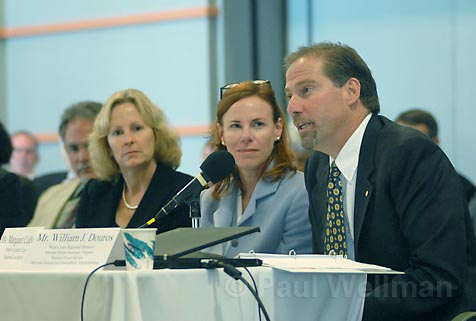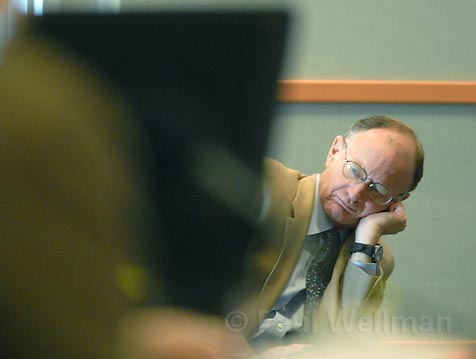Congressional Subcommittee Comes to UCSB
Witnesses Plead for Reinvigorated Marine Sanctuaries

The only person that did not speak in favor of stronger ecosystem protection during a Congressional Subcommittee hearing that was held at UCSB on Saturday, November 3, was Jim Martin of Fort Bragg, California. Martin was one of eight expert witnesses called to testify before the Subcommittee on Fisheries, Wildlife, and Oceans. Santa Barbara’s Rep. Lois Capps sits on the subcommittee. The field hearing was the first of several that the subcommittee expects to hold in various parts of the nation before introducing a bill to re-authorize the National Marine Sanctuary Program (NMSP). Martin, the West Coast Regional Director of the Recreational Fishing Alliance may have been outnumbered, and members of the subcommittee may have directed fewer questions to him than to the other expert witnesses, but Congresswoman Capps did give him the last word, asking him in what ways the public participation in the crafting of sanctuary management plans was lacking. “You can’t manage an ecosystem,” Martin responded, though it was something of a non sequitur. “You can manage a species, and you can manage people, but you can’t manage an ecosystem.”
Earlier, he had said that more fishers needed to be represented on sanctuary management, more closely proportionate to their use of the sanctuaries compared to other citizens. Gripes that recreational fishers have with sanctuary management include certain harvesting bans, the ban on bottom-contact gear, “and, of course, the Channel Islands Marine Reserve in federal waters. We’re not saying we’re against protected areas,” Martin added. “We’re saying if you have a fishing management council, leave fishing management to that council.” He nonetheless gave the sanctuary program credit for reducing pollution in coastal waters.

Accompanying Capps to Santa Barbara was the subcommittee chair, Rep. Madeleine Z. Bordallo, of Guam, who, like Capps, clearly favored stronger ocean protections. The other expert witnesses included Monterey Bay Aquarium executive director Julie Packard; Professor Steven Gaines, director of UCSB’s Marine Science Institute; reef diver and film producer Bob Talbot; Stanford Law School lecturer Meg Caldwell; Dennis Takahashi-Kelso, the executive vice president of the Ocean Conservancy; Diane Black, director of development services for the County of Santa Barbara and the chair of the Channel Islands National Marine Sanctuary Advicsory Council; and Bill Douros, West Coast Regional Director of the National Marine Sanctuary Program.
Witnesses told the subcommittee that the NMSP’s mission needed to be clearly defined as resource management primarily, and that the sanctuaries need more money for research and monitoring. They said that sanctuary managers needed the authority to more easily declare portions of the sanctuaries off-limits to fishing, in order to replenish diminishing species and the ecosystems of which they are part. They all agreed-including Martin-that the Bush administration’s de facto moratorium on declaring new sanctuaries, by withholding money, needs to be lifted.

The most dramatic moment in the two-hour hearing came when Talbot, following mind-numbing discussions about quantifiable benchmarks, public participation processes, and timelines for periodic policy review, exclaimed, “The ocean is dying and we’re sitting here talking about it! We have very little time to talk about this, and we really have to act.” He talked about the difficulty of conveying this urgency to the public when most Americans see only images of “blue water and leaping dolphins.” Capps pursued this line, asking for ideas on how to educate and inspire the public-including people who do not live on the coasts-to support ocean preservation. More university students need to spend more time on research vessels, was the response, and there need to be more films, and more interpretive centers. The witnesses said that it would help if sanctuary managers’ authority extended to more control over what came into the ocean from the shore. Everything will come together, said Packard, “if Americans learn to protect nature wherever they live.”



